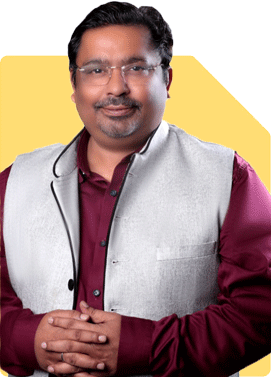Ramalingam Kalirajan |10874 Answers |Ask -Follow
Mutual Funds, Financial Planning Expert - Answered on Jun 21, 2024
He has an MBA in finance from the University of Madras and is a certified financial planner.
He is the director and chief financial planner at Holistic Investment, a Chennai-based firm that offers financial planning and wealth management advice.... more

Hi, My wife and I combined make 12.5 Lakh a month. We have 2 houses: 1 in Greater Noida worth 2 crores, 1 in Goa worth 5 crores, a parental property worth 1.25 crores. I have 2 lakhs in stocks, 5 lakhs in crypto, I have 30 lakh in Fixed deposit for working capital for my business. I want to have a corpus of 2 crores in 7 years. Any advise on how can I make it happen
Assessing Your Current Financial Status
Firstly, it’s commendable that you have diversified assets. You have properties in Greater Noida and Goa, a parental property, investments in stocks, crypto, and a fixed deposit for your business. This diversification is a solid strategy. Let's focus on creating a balanced portfolio that maximizes returns while managing risks.
Setting Clear Financial Goals
Your target is to accumulate Rs 2 crores in 7 years. To achieve this, we'll need to focus on disciplined savings and strategic investments. Consistency is key here, so let's break down how you can channel your income and existing assets towards this goal.
Investment Strategy
Diversified Mutual Funds Portfolio
Actively managed mutual funds can be a great option. They offer the potential for higher returns compared to index funds. Certified Financial Planners (CFPs) can help you choose funds that align with your risk tolerance and goals. Regular funds, managed by skilled fund managers, often outperform the market, giving you an edge.
Systematic Investment Plan (SIP)
Investing in mutual funds through SIPs ensures regular investment without timing the market. SIPs inculcate discipline and can average out market volatility. Aim to allocate a significant portion of your monthly savings to SIPs. This will help you build a substantial corpus over time.
Balanced Funds
These funds offer a mix of equity and debt, providing growth potential with a cushion against market downturns. Balanced funds are less volatile compared to pure equity funds and can be a good addition to your portfolio for steady growth.
Equity Mutual Funds
Equity funds have the potential for high returns, especially over the long term. Diversify across large-cap, mid-cap, and small-cap funds to balance risk and return. Consult with your CFP to pick the right funds based on your risk appetite.
Existing Investments
Stocks and Crypto
You have Rs 2 lakhs in stocks and Rs 5 lakhs in crypto. These are high-risk, high-reward investments. Regularly review these investments with your CFP. Consider reallocating some funds from crypto to more stable investment options if it aligns with your risk tolerance.
Fixed Deposits
The Rs 30 lakh in fixed deposits is a safe option, providing stability. However, FD rates are typically lower than potential returns from mutual funds. Discuss with your CFP about gradually reallocating a portion of this amount into diversified mutual funds for better growth prospects.
Emergency Fund
Ensure you have an emergency fund equivalent to at least 6-12 months of your monthly expenses. This should be easily accessible and kept in a separate savings account or a liquid mutual fund. It provides a financial cushion in case of unforeseen events.
Retirement Planning
While focusing on your 7-year goal, don’t lose sight of long-term retirement planning. Consult your CFP to integrate retirement planning into your overall financial strategy. Diversify your investments to ensure a comfortable retirement while achieving your Rs 2 crore goal.
Insurance Coverage
Adequate insurance coverage is essential. Ensure you have sufficient life and health insurance. Life insurance should cover at least 10-15 times your annual income. Health insurance should cover your family adequately. This protects your financial plan from unforeseen events.
Tax Planning
Efficient tax planning helps you save and invest more. Utilize tax-saving instruments under Section 80C, 80D, and others. Investing in ELSS (Equity Linked Savings Scheme) mutual funds can help in tax saving while contributing to your investment goals. Consult your CFP to optimize your tax-saving strategy.
Review and Rebalance Portfolio
Regularly reviewing and rebalancing your portfolio is crucial. Markets fluctuate, and your investment allocations may drift from your original plan. Rebalancing helps in maintaining the desired risk level and aligns your portfolio with your financial goals. Your CFP can assist in this periodic review and adjustment.
Avoiding Common Pitfalls
Avoiding Index Funds
Index funds passively track market indices and may not offer the same growth potential as actively managed funds. Actively managed funds can outperform the market through strategic stock picking and risk management by professional fund managers.
Disadvantages of Direct Funds
Direct funds may seem cost-effective but lack professional advice. Investing through a Certified Financial Planner provides personalized advice, ensuring your investments align with your goals and risk profile. Regular funds, managed through an MFD with CFP credentials, can provide better guidance and performance tracking.
Final Insights
Building a corpus of Rs 2 crores in 7 years is an achievable goal with disciplined savings and smart investments. By focusing on diversified mutual funds, regular investments through SIPs, and periodic portfolio review, you can reach your target. Your current income and asset base provide a strong foundation. Utilize the expertise of a Certified Financial Planner to navigate your investment journey, ensuring your financial plan remains on track.
Stay committed to your financial plan, keep reviewing your progress, and make adjustments as needed. With consistent effort and informed decisions, you will achieve your financial goals.
Best Regards,
K. Ramalingam, MBA, CFP,
Chief Financial Planner,
www.holisticinvestment.in
You may like to see similar questions and answers below
Omkeshwar Singh | Answer |Ask -Follow
Head, Rank MF - Answered on Nov 16, 2022
Ramalingam Kalirajan |10874 Answers |Ask -Follow
Mutual Funds, Financial Planning Expert - Answered on Jun 26, 2024
Naveenn Kummar |233 Answers |Ask -Follow
Financial Planner, MF, Insurance Expert - Answered on Sep 04, 2025
Naveenn Kummar |233 Answers |Ask -Follow
Financial Planner, MF, Insurance Expert - Answered on Sep 10, 2025
Ramalingam Kalirajan |10874 Answers |Ask -Follow
Mutual Funds, Financial Planning Expert - Answered on Sep 11, 2025
Mayank Chandel |2565 Answers |Ask -Follow
IIT-JEE, NEET-UG, SAT, CLAT, CA, CS Exam Expert - Answered on Dec 08, 2025
Mayank Chandel |2565 Answers |Ask -Follow
IIT-JEE, NEET-UG, SAT, CLAT, CA, CS Exam Expert - Answered on Dec 08, 2025
Anu Krishna |1746 Answers |Ask -Follow
Relationships Expert, Mind Coach - Answered on Dec 08, 2025
Ramalingam Kalirajan |10874 Answers |Ask -Follow
Mutual Funds, Financial Planning Expert - Answered on Dec 08, 2025
Samraat Jadhav |2499 Answers |Ask -Follow
Stock Market Expert - Answered on Dec 08, 2025
Ramalingam Kalirajan |10874 Answers |Ask -Follow
Mutual Funds, Financial Planning Expert - Answered on Dec 08, 2025
Radheshyam Zanwar |6737 Answers |Ask -Follow
MHT-CET, IIT-JEE, NEET-UG Expert - Answered on Dec 08, 2025
Nayagam P P |10852 Answers |Ask -Follow
Career Counsellor - Answered on Dec 07, 2025

Research Career Prospects: IISc, IITs, and Beyond: For research-oriented careers, the Integrated M.Sc Physics program at Amrita provides an exceptional foundation. Amrita's curriculum specifically aligns with GATE and UGC-NET examination syllabi, and the institution emphasizes early research engagement. The faculty at Amrita actively publish research in Scopus-indexed journals, with over 60 publications in international venues within the past five years, exposing you to active research environments.
To pursue research at premier institutions like IISc, you would typically follow the PhD pathway. IISc accepts M.Sc graduates through their Integrated PhD programs, and with your Amrita M.Sc, you're eligible to apply. You'll need to qualify the relevant entrance examinations, and your integrated program's emphasis on research fundamentals provides strong preparation. The final year of your Integrated M.Sc is intentionally structured to be nearly free of classroom commitments, enabling engagement with research projects at institutes like IISc, IITs, and National Labs. According to Amrita's data, over 80% of M.Sc Physics students secured internship offers from reputed institutions during academic year 2019-20, directly facilitating research career transitions.
Placement and Direct Employment Opportunities: Amrita University boasts a comprehensive placement ecosystem with strong corporate and government sector connections. According to NIRF placement data for the Amrita Integrated M.Sc program (5-year), the median salary in 2023-24 stood at ?7.2 LPA with approximately 57% placement rate. However, these figures reflect general placement trends; physics graduates often secure higher packages in specialized technical roles. Many graduates join software companies like Infosys (with early offers), Google, and PayPal, where their strong analytical and computational skills command competitive compensation packages ranging from ?8-15 LPA for entry-level positions.
The Department of Corporate and Industrial Relations at Amrita provides intensive three-semester life skills training covering linguistic competence, data interpretation, group discussions, and interview techniques. This structured placement support significantly enhances your employability in both government and private sectors.
Government Sector Opportunities: UPSC, BARC, DRDO, and ISRO: Your M.Sc Physics degree opens multiple avenues for prestigious government employment. UPSC Geophysicist examinations explicitly list M.Sc Physics or Applied Physics as qualifying degrees, enabling you to compete for Group A positions in the Geological Survey of India and Central Ground Water Board. The age limit for geophysicist positions is 32 years (with relaxation for reserved categories), and the exam comprises preliminary, main, and interview stages.
BARC (Bhabha Atomic Research Centre) actively recruits M.Sc Physics graduates as Scientific Officers and Research Fellows. Recruitment occurs through the BARC Online Test or GATE scores, with positions in nuclear science, radiation protection, and atomic research. BARC Summer Internship programs are available, offering ?5,000-?10,000 monthly stipends with opportunity for future scientist recruitment.
DRDO (Defense Research and Development Organization) recruits M.Sc Physics graduates through CEPTAM examinations or GATE scores for roles involving defense technology, weapon systems, and laser physics research. ISRO (Indian Space Research Organisation) regularly advertises scientist/engineer positions through competitive recruitment for candidates with strong physics backgrounds, offering opportunities in satellite technology and space science applications.
Other significant employers include the Indian Meteorological Department (IMD) recruiting as scientific officers, and NPCIL (Nuclear Power Corporation of India Limited), offering stable government service with competitive compensation packages exceeding ?8-12 LPA for scientists.
Alternate Career Pathways: UPSC, CDS, and AFCAT: UPSC Civil Services (IFS - Indian Forest Service): M.Sc Physics graduates qualify for UPSC Civil Services examinations, with the forest service offering opportunities for science-based administrative roles with potential to reach senior government positions.
CDS/AFCAT (Armed Forces): While AFCAT meteorology branches specifically require "B.Sc with Maths & Physics with 60% minimum marks," the technical branches (Aeronautical Engineering and Ground Duty Technical roles) require graduation/integrated postgraduation in Engineering/Technology. An M.Sc Physics integrates well with technical qualifications, though you would need engineering background for direct officer entry. However, you remain eligible for specialized technical interviews if applying through alternate defence channels.
UGC-NET Examination: This pathway leads to Assistant Professor positions in central universities and colleges across India. NET-qualified candidates receive scholarships of ?31,000/month for 2-year JRF positions with PhD pursuit, transitioning to Assistant Professor salaries of ?41,000/month in government institutions. This route provides long-term academic career security with research opportunities.
Private Sector Technical Roles
M.Sc Physics graduates are increasingly valued in data science, software engineering, and technical consulting. Companies actively recruit physics graduates for software development, where strong problem-solving and logical reasoning translate to competitive packages of ?10-20 LPA. Specialized domains including quantum computing development, financial modeling, and scientific computing offer premium compensation. Your minor in Scientific Computing makes you particularly attractive to technology companies requiring computational expertise.
International Opportunities and Higher Studies Abroad
An M.Sc from Amrita facilitates admission to PhD programs at international institutions. German universities offer tuition-free or low-fee MSc Physics programs (2 years) with scholarships like DAAD providing €850+ monthly stipends. US universities accept M.Sc graduates directly for PhD positions with full funding (tuition coverage + stipend). These pathways require GRE scores and strong Statement of Purpose articulating research interests. Research collaboration opportunities exist with Max Planck Institute (Germany) and CalTech Summer Research Program (USA), both welcoming Indian M.Sc students.
Essential Skills and Certifications to Develop Immediately: Programming Languages: Start learning Python immediately—it's universally used in research and industry. Dedicate 2-3 hours weekly to data analysis, scientific computing libraries (NumPy, SciPy, Pandas), and machine learning fundamentals. MATLAB is equally critical for physics applications, particularly numerical simulations and data visualization. Aim to complete MATLAB certification courses within your first year.
Research Tools: Learn Git/version control, LaTeX for scientific documentation, and data analysis frameworks. These skills are indispensable for publishing research papers and collaborating on projects.
Certifications Worth Pursuing: (1) MATLAB Certification (DIYguru or MathWorks official courses) (2) Python for Data Science (complete certificate programs from platforms like Coursera) (3) Machine Learning Fundamentals (for expanding technical versatility) & (4) Scientific Communication and Technical Writing (develop through departmental workshops)
Strategic Internship Planning: Leverage Amrita's research connections systematically. In your third year, apply to BARC Summer Internship, IISER Internships, TIFR Summer Fellowships, and IIT Internship programs (like IIT Kanpur SURGE). These expose you to frontier research while establishing connections for future PhD or scientist recruitment. Target 2-3 research internships across different specializations to develop versatility.
TO SUM UP, Your Integrated M.Sc Physics degree from Amrita positions you exceptionally well for competitive research careers at IISc/IITs, prestigious government scientist roles at BARC/DRDO/ISRO, and international PhD opportunities. The program's scientific computing emphasis differentiates you in the job market. Immediate priorities: (1) Master Python and MATLAB within the first two years; (2) Engage in research projects starting year 2-3; (3) Target internships at premiere research institutions; (4) Prepare GATE while completing your degree for maximum flexibility in recruitment; (5) Consider UGC-NET for long-term academic stability. Your career trajectory will ultimately depend on developing strong research fundamentals, demonstrating consistent excellence in specialization areas, and strategically selecting internship and research opportunities. The rigorous Amrita program combined with disciplined skill development positions you for exceptional career success across multiple sectors. Choose the most suitable option for you out of the various options available mentioned above. All the BEST for Your Prosperous Future!
Follow RediffGURUS to Know More on 'Careers | Money | Health | Relationships'.
Nayagam P P |10852 Answers |Ask -Follow
Career Counsellor - Answered on Dec 07, 2025
Radheshyam Zanwar |6737 Answers |Ask -Follow
MHT-CET, IIT-JEE, NEET-UG Expert - Answered on Dec 06, 2025

Good luck.
Follow me if you receive this reply.
Radheshyam


























